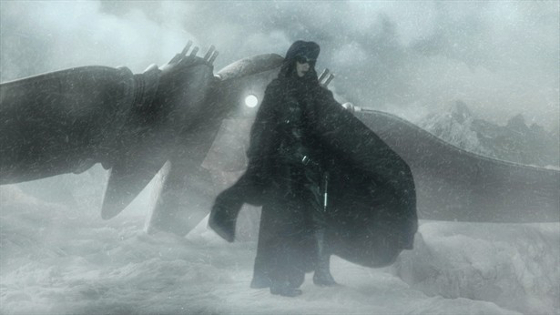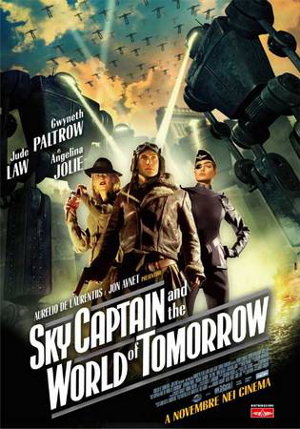It’s really hard to say something new about a divisive film like Sky Captain and the World of Tomorrow, especially when you’re writing about it ten years after its release.
The fact is, that there are very few films of its ilk. Boasting some of the best visuals of the past decade and a visual style all its own, Sky Captain is one of those films that you either love or hate.
Though critics seemed to mostly give it positive reviews (72% on Rotten Tomatoes), most users disliked the film (46%). Most of my friends have never heard of Sky Captain, and after explaining a bit about the film, they seem uninterested.
I’m pretty sure they’re wrong, and here’s why.
Joseph “Sky Captain” Sullivan really loves his airplane, a modified P-40 Warhawk. He stresses over its condition constantly, grimacing every time it takes the smallest hint of damage. It’s a safe and familiar environment in which he can accomplish fantastic things. In much the same way, director Kerry Conran feels safe and familiar within the realm of classic science fiction, and uses the genre to its fullest potential in a number of innovating ways to create one of my favorite films.

Shot entirely on a soundstage using mostly bluescreen to fill in the environments, Sky Captain is a study in making a film almost entirely digital with the exception of live actors. Written and directed by Conran, Sky Captain is an homage to science fiction, comic books, and the radio broadcasts of the 1930’s and ‘40’s.
One of the really great things with this film is its stylization and the usage of technology to create the world of the film. As mentioned previously, the entire film was shot on a soundstage, mostly with bluescreen. While some may see this as the beginning of the death of practical special effects and set building, it’s amazing to see how, even in 2004, such a feat was possible. The only parts of the film that weren’t digitally created were some sets, and the actors themselves. In crowds, extras were shot on the soundstage, and added in as needed in a number of places. This gives the film a very comic book-y feel in comparison to other films.
The film is based on a six-minute short by Conran, titled The World of Tomorrow in which some flying robots attack New York City. When director Jon Avnet saw the film, he agreed to produce the film, and when the short was shown to Gwyneth Paltrow, she immediately volunteered for the film at a lower rate than usual. Centering around Sullivan and reporter Polly Perkins (Paltrow), the duo uncover and attempt to stop a secret plot by the director of the mysterious Unit 11, Dr. Totenkopf (represented by deceased film star Sir Laurence Olivier, brought to life through the usage of archival footage) or risk the end of the world and all life as we know it.

Speaking of the feel and style of the film, comic books are the perfect analogy here. There’s a few scenes towards the beginning, especially that give a feel of comic books brought to life, for example the crowd pointing towards the sky at the invading robots, or policemen raising their Tommy guns to defend New York, both in a group of three, one after the other. It’s noticeable enough to be iconic, and becomes a sort of repeated visual motif throughout the film in different ways. Additionally, the film is in color, however, it’s colorized and filtered in such a way that it looks like an old photograph, with lots of fade, and each object in the frame has a “glow” about it. It looks like a classic science fiction film from the 1950’s and I love every minute of it. Everything from the costumes, to the dialog, to the design of the gadgets and robots in the film screams classic science fiction from this film. It’s an homage. A labor of love.
Finally, one of the great things about Sky Captain and the World of Tomorrow is the sheer number of nods to other works within the film. A few of the bigger ones are Polly’s line “They’re crossing Sixth Avenue… Fifth Avenue… they’re a hundred yards away…” which is a direct quote from Orson Welles’ “War of the Worlds” radio broadcast hoax, the oversize radio tower when a distress message is sent to Sky Captain is a direct reference to now-defunct RKO studios, a picture of Godzilla in a brief glimpse of a Japanese newspaper, and the numbers “1138” in homage to George Lucas (whose first film was called THX 1138, and who later used the number in a variety of other ways in his other films). The list goes on, but for the sake of brevity, I won’t. The laundry list of classic references by the filmmakers shows the true amount of fan service present in Sky Captain, and makes the film that much more enjoyable for the style espoused in this film.
It’s not the greatest film of all time, but despite having such a poor popular response, and a mixed critical response, as a genre piece, I believe that Sky Captain and the World of Tomorrow is worthy of the title “guilty pleasure” for many.
Except in my case, there’s nothing guilty about it at all.






{ 1 comment }
Great write-up! And I’m proudly one of those people who considers Sky Captain and the World of Tomorrow to be the greatest movie of all-time! (We’re out there, and we live among you!) Read my review of the DVD (“The Greatest Movie of All-Time!!!”) on Amazon to find out why! Thanks!
Comments on this entry are closed.